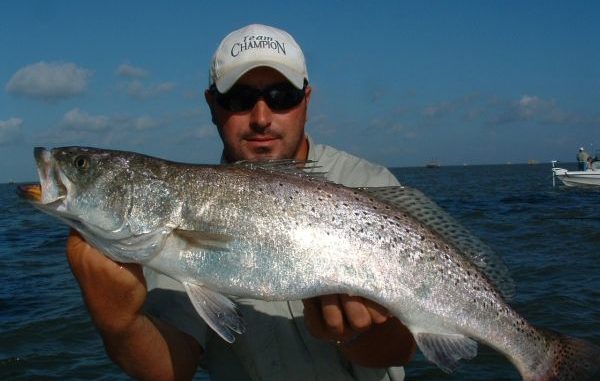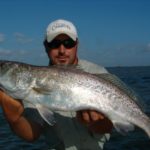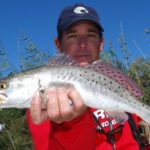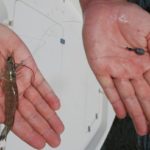
Everything seems magnified down the river. Long boat runs are common. Frequent fogs seem thicker there than elsewhere. Navigation can be tricky because sandbars seem to shift on any whim.
But the rewards in either big catches of small speckled trout or good catches of big speckled trout are worth it.
Both of our experts — Brandon Carter of Reel Shot Guide Service (985-969-0810) and Nash Roberts IV of Fishhunter Guide Service (800-887-1385) — reported mixed but good catches in 2013 until the fall months of October into December, when speckled trout fishing became excellent.
“Last year we had a great fall: October to mid-December,” Roberts said, “but until then, our best months were March, April and May.
“It got real windy on us in June and July. Then the trout bite just petered out in August.”
Roberts normall fishes both sides of the river delta, but last year until October he fished the west side almost exclusively because the water on the east side of the river never cleared up, something he attributed to the Mardi Gras break (not to be confused with Mardi Gras Bayou directly across the river from Fort Jackson) located about a mile south of Beschel’s Marina in Pointe-la-Hache.
Carter described last year’s fishing downriver as better than the last three or four years, although it started late because of a couple of late cold snaps.
“Normally,” he said, “we can count on catching trout the first of April. Last year it was the third week of April.”
Some of that he attributed to land lost since Hurricane Katrina.
“The nooks and pockets in the backs of bays that harbored trout are gone,” Carter said. “There is definitely more fishing pressure and a lot less places to fish since Katrina.
“I don’t know if the oil spill had an effect. We thought that after the spill had shut down fishing for so long, we would slam the fish but we didn’t.
The beginning of the 2013 season began with a run of big trout, but in June catches averaged out with an occasional big speck in the mix.
“During the summer we caught trout everywhere,” Carter said with a surprising lack of enthusiasm.
Hotspots included Main Pass rigs, over cane stubble left from eroded islands and points, sand bars and beaches, the South Pass rocks and the Southwest Pass Rocks.
They weren’t in the same spot every day, but there alway were fish available somewhere.
“As we got further into the season, we caught an absolute ton of short fish—10 to 12 inches,” Carter said. “That told me that we had a successful spawn in 2012 when the river was low.
“We actually saw them all year, but by July the backs of the bays were full of them.”
Both men agreed that fall and early winter catches were outstanding until brutally cold weather set in. Neither noted any fish kills, which Carter attributed to the fish already being in their holding patterns in deep water.
Not surprisingly, since they fish at the end of the Mississippi River funnel that channels snow melt water from half a continent through their fishing hole, both are a little nervous about the spring — but have a positive longer-term outlook.
“The big snowfall up north,” Roberts said, “will likely mean a higher and longer high river, which in turn means muddy water where I don’t want to see it. Early in spring, I like to fish Buras, but cold, muddy water may force me to shift all the way to Delacroix Island.
“It is likely to be tough in the spring — tough to find clean water — until the river drops, perhaps well into the summer. I’m hoping I’m wrong.”
He said the problem with a high river is more about visibility than a lack of trout.
“I actually don’t find that freshwater runs the fish out,” Roberts said. “As soon as we get a change that pushes the muddy water out, the fish are there and can be caught. As the summer goes on, I think that it may be better than last year, but the fish won’t be caught early.”
And Roberts said there should plenty of solid if not huge fish available for harvest.
“I expect to see a lot of average-to-nice-sized fish because of the numbers of small fish we saw in late summer and fall,” he said. “This may seem to contradict my prediction about the high river, but I think that we will see them later.”
Carter also expressed concerns about river runoff.
“From what I’ve seen, a lot of places up north are holding a big snow pack,” he said. “The river has remained low for much of the winter, so it can hold some runoff, but how much is coming remains to be seen.”
When the river flow picks up, this veteran big-trout angler said success is all about knowing what to look for.
“Spots that receive river water directly will be more affected,” Carter said. “Spots with more tidal flush and away from direct river currents will be less affected. Solid banks with no breaks for river water to come in will be better for fishing. The river water will have to come around and into those spots; it will be floating on top of a saltwater layer.
“Tidal push can move in more saltwater under the freshwater layer than you think. Some of these better spots can be small, sometimes only 100 yards across —and you may or may not be able to see any change in water color. There is nothing like fishing with someone with experience down the river to find those spots.”
But the action might be slow to kick off this spring.
“I am most worried about the early part of the fishing year,” Carter said. “It’s definitely colder than last year, and cold water temperatures will slow fish activity.
“But once we get into our warmer weather pattern, I’m expecting a really, really good year. The number of 14- to 16-inch specks was off the charts. They should be 18 to 25 inches long this summer.”
Both men recommended fishing with soft plastics in April. Roberts prefers tight-lining; Carter wants to fish under a cork, and the noisier the cork the better.
Green water is the name of the game for Roberts.
On the west side of the river, fish anything with green water that has 3 feet of water or less and is over oyster shells, he said.
On the east side, which is much less protected than the west side, fishermen might have to retreat as far northward as Black Bay because everything south of Buras will be muddy.
Carter recommended targeting cove-shaped banks. Speckled trout will not be tight on the canes, he said, but rather scattered out over the area of the cove.
The best tactic is to drift across the cove and hopefully take five or six fish a drift.
The popping cork should be set so the bait rides about a foot over the bottom. Contrary to many recommendations, Carter’s preference is to use lighter-colored plastics like opening night, even in murky water.
By May, Carter finds that specks move out of pockets and coves looking for saltier water. They tend to congregate off points of major passes. Unlike minor passes, these have long stretches of solid banks.
Submerged stubble fields of eroded rouseau canes can be “red hot.”
During the month, Cartter shifts gradually away from using plastics to toward live shrimp under corks.
The shift in trout preference for live shrimp instead of plastics also affects Roberts, who admittedly hates to fish with live shrimp.
“Live shrimp means messing with little trout, messing with catfish and constant rebaiting, but by late June, I’ll have them on my boat every day,” he said.
On the east side of the delta, Roberts fishes from the Iron Banks to Battledore Reef. On the west side, he concentrates on shallow reefs inside the beach line from Four Bayou Pass to Bayou Coquette.
This May pattern will extend through June and July for Roberts.
June usually is an also extension of the May pattern for Carter, except that speckled trout will move even farther outside to the extreme tips of points and to oil and gas rigs. Live bait is consistently best, he said, either shrimp under a cork or croakers under a cork or on a Carolina rig.
In July, he concentrates on rigs such as those found out of Main Pass, around Sandy Point or in West Bay. He uses a sliding cork as well as a light Carolina rig to present his shrimp and croakers.





